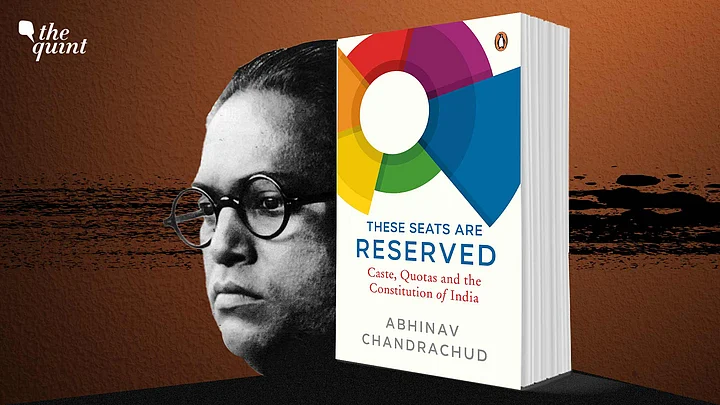India has one of the most comprehensive and sophisticated affirmative action programmes in the world. And many youngsters may not know this but the key principles of the country's reservation policy were devised during the colonial period itself, especially towards the end of the British Raj. India's colonial government and socially aware princely states played an active role in shaping the contours of the policy in the first half of the 20th century.
Abhinav Chandrachud makes this history come alive in his new book These Seats Are Reserved: Caste, Quotas and the Constitution of India. However, the book is much more than just a simple recounting of important episodes in the history of the reservation policy. It's rather an accessible and finely written introduction to one of the most controversial and debated issues in the contemporary India, touching upon constitutional debates, judicial interventions and politics.
The book is all the more necessary when one comes across people dishing out really passionate opinions and 'facts' on the 'quotas,' asserted with utmost confidence, but which tend to be supremely ill-informed and based on the notorious WhatsApp forwards.
The Three Backward Classes
The question of who the backward classes are, has vexed politicians, judges and academics alike for decades. In this context, the author brings to our attention an interesting fact – that the terms backward classes and depressed classes were imported to India from Europe.
"The terms 'backward classes' and 'depressed classes' were not invented in India. They came to British India from 19th-century England, which was a class-based society. However, these terms underwent a transformation upon being imported to India and the word 'class' in 'backward class' was understood here to mean 'caste' or 'tribe'."
The Indian State, for administrative purposes, has carved out three distinct backward classes – (i) Scheduled Castes, (ii) Scheduled Tribes, and (iii) Other Backward Classes. In chapter 1, the author shows the journey of the term depressed classes to scheduled classes to finally Scheduled Castes.
The term depressed classes originally included backward tribes as well. However, once the term was narrowed down to include only those communities that faced untouchability, there arose a need to create a separate category for the backward tribes. This culminated in the creation of Scheduled Tribes category in India's Constitution.
In chapter 2, the author traces the history of the term backward classes and more specifically Other Backward Classes. The princely states of Kolhapur and Mysore as well as the provincial governments of Madras and Bombay have played an important role in generating the discursive field of backward classes and the need for affirmative action policies for them.
In 1902, Shahu Maharaj, the king of Kolhapur, issued a proclamation reserving 50% government jobs to the backward classes. Similar policies were instituted in Madras, Mysore and Bombay for backward classes in later decades.
Class vs Caste
Much ink has been spent on whether the word classes in backward classes is limited only to castes and tribes (aka groups requiring birth-based membership) or can be read more broadly. The high court and Supreme Court judges, in cases like MR Balaji v State of Mysore, have tried to argue that caste and tribe cannot be the only basis for reservation and the legislators should take factors like economic backwardness into account too. The author, rightly in my opinion, takes the position that classes essentially meant castes and cites Dr BR Ambedkar in his defence.
"During the debate on the first amendment in the provisional parliament, Ambedkar referred to the backward classes as a ‘collection of certain castes’. There is therefore no doubt that India’s founding fathers and mothers intended for the word ‘class’ in the reservations provisions of the Constitution to be used as a synonym for ‘caste’ or ‘tribe’."
In the Indra Sawhney judgment, the Supreme Court seemed to have settled this debate by stressing on caste as the key determinant of backwardness. This landmark judgment, while upholding 27% quota to the OBCs, had cancelled PV Narasimha Rao's order of 1992 reserving 10% seats to economically backward communities. However, the 103rd amendment to the Constitution has now given constitutional validity to economic backwardness as a sole criterion for reserving seats by creating the category of Economically Weaker Sections of Citizens, thus making the class vs caste debate redundant.
The book also probes other questions such as the exclusion of creamy layer from reservation benefits, 50% ceiling on quotas, reservation in promotion, and how factors like migration, marriage and change of religion may or may not affect one's eligibility to avail quotas.
India's reservation policy aims at redistribution of resources, which is fundamentally a political issue. There are differing opinions on who the beneficiaries of this distributive justice should be, what should be the nature of the redistribution and whether the State should take up such a programme at all. Since the quotas, at least in theory, concern all sections of society, it is no wonder that the topic is always in news and always generates a heated discussion.
Chandrachud's book, by explaining all the key concepts related to this policy in a few short chapters, in a language that will appeal to students and politically less savvy too, intends to create a politically informed public. This is all the more necessary when the incidents of reserved category students and employees being ridiculed and harassed by the upper castes in the higher educational institutions and at workplaces respectively are so rampant.
While the book doesn't have the thoroughness and density of Marc Galanter's magnum opus from 1984, Competing Equalities: Law and the Backward Classes in India, the choice was most probably deliberate. The book is aimed more at general public and not academics, and serves more like a primer on the issue. Chandrachud has succeeded exceedingly in the task that was before him.
